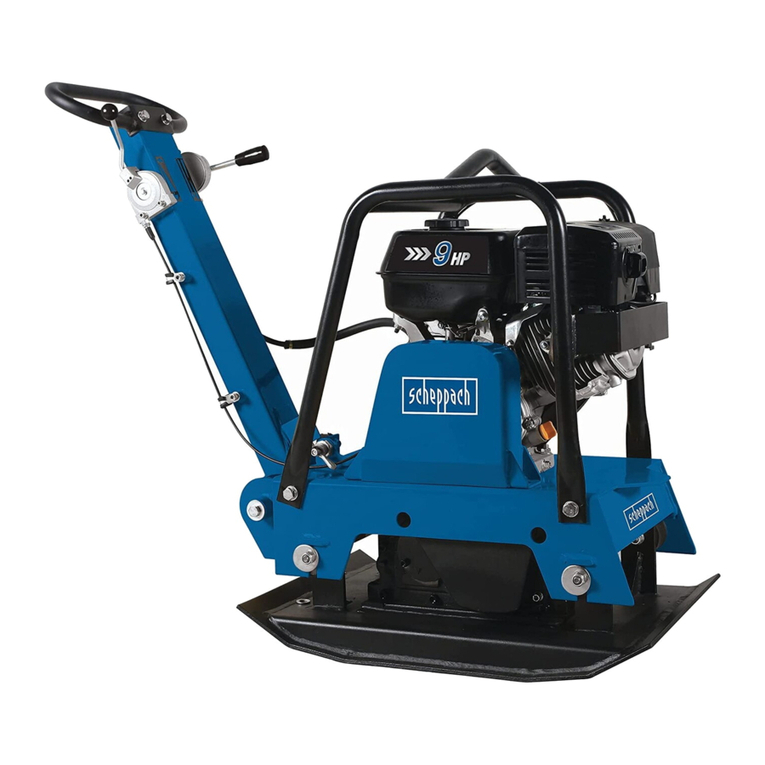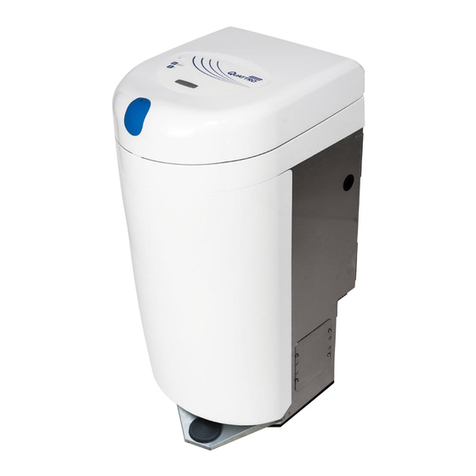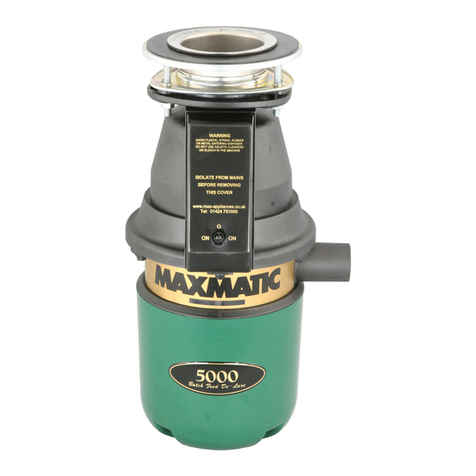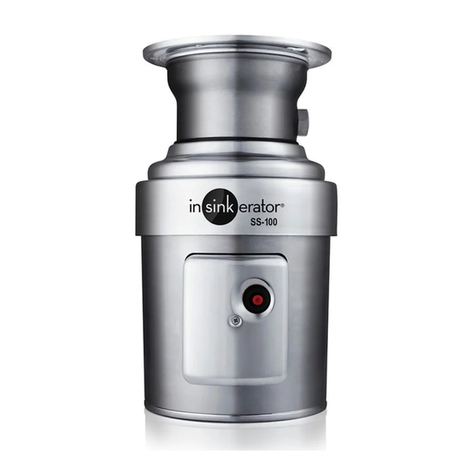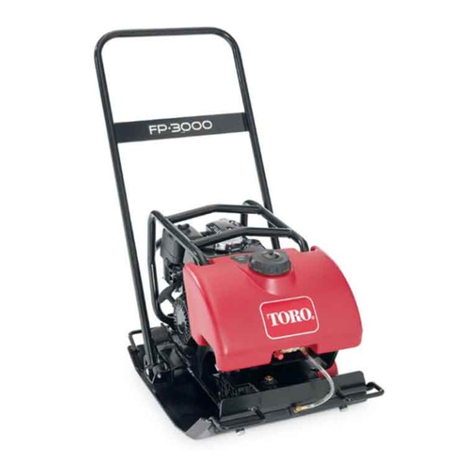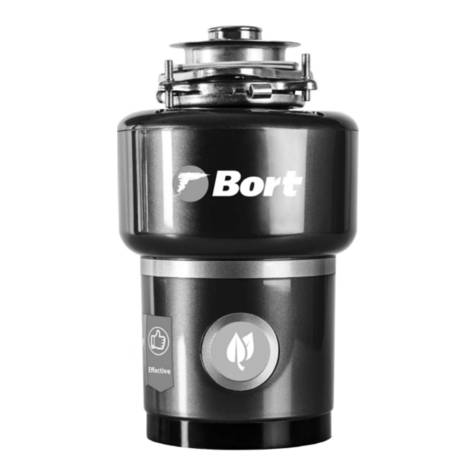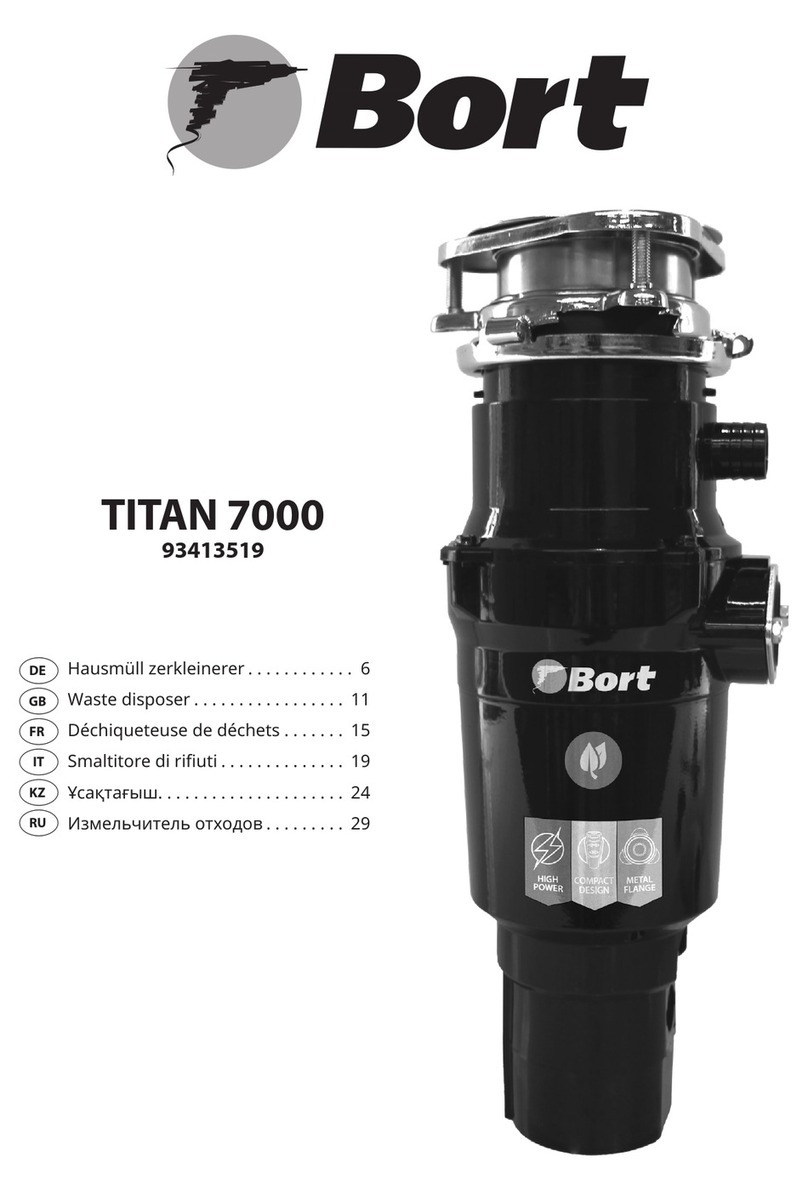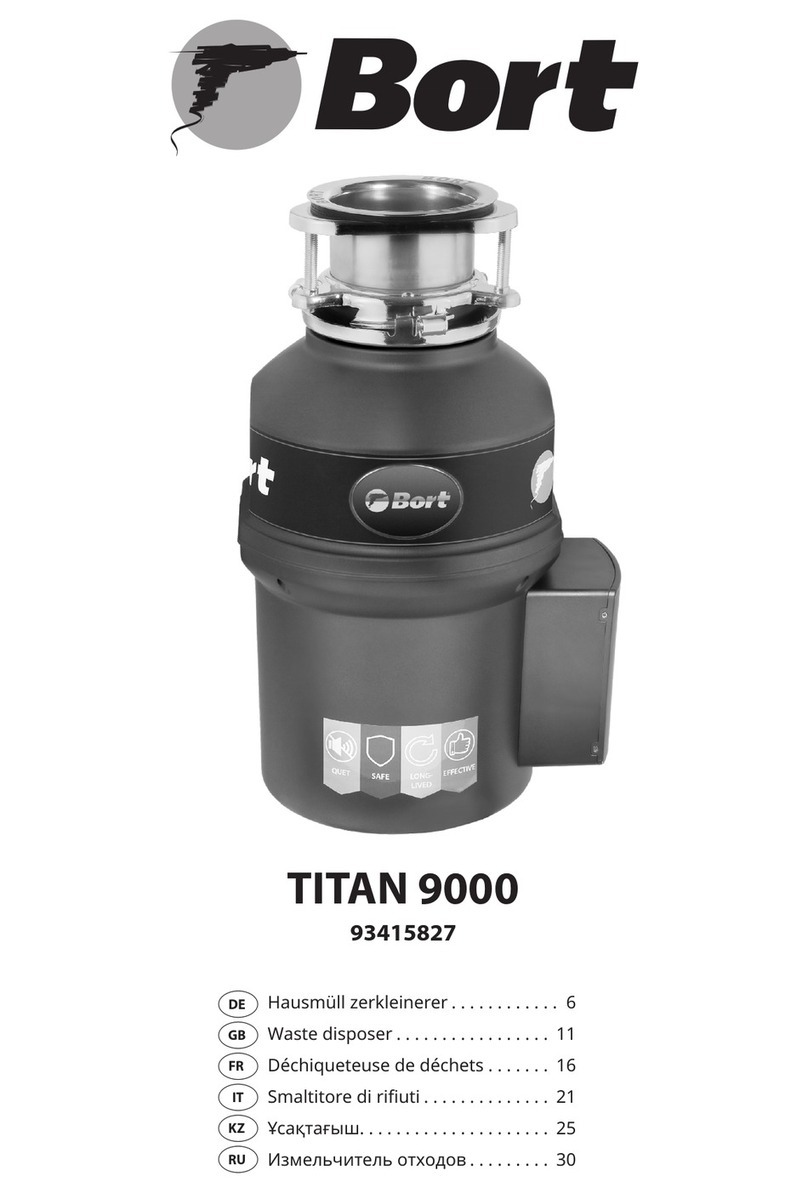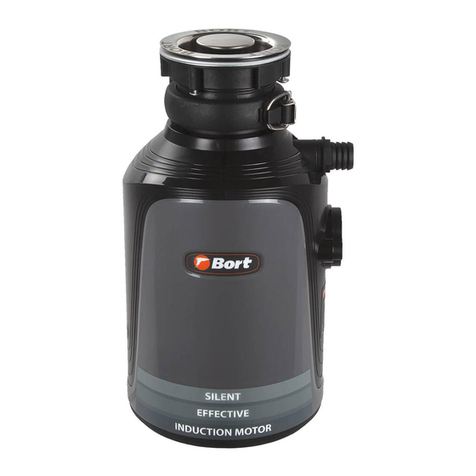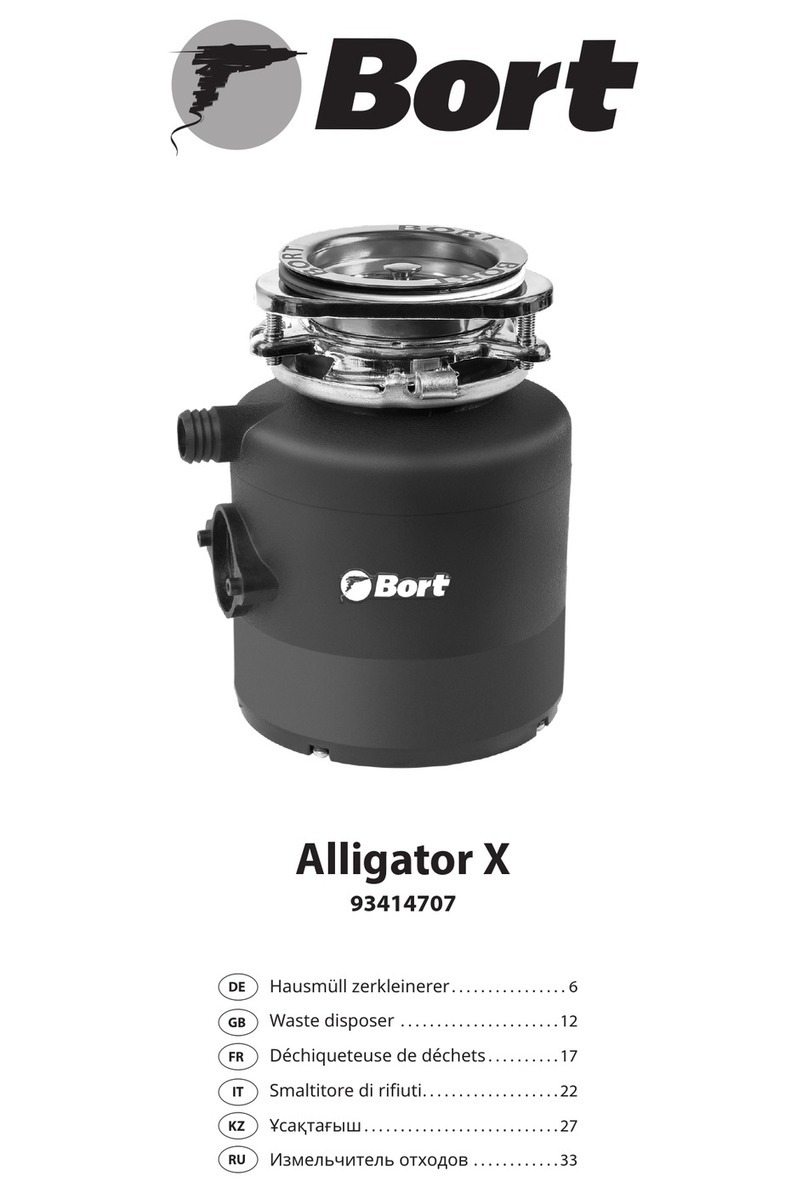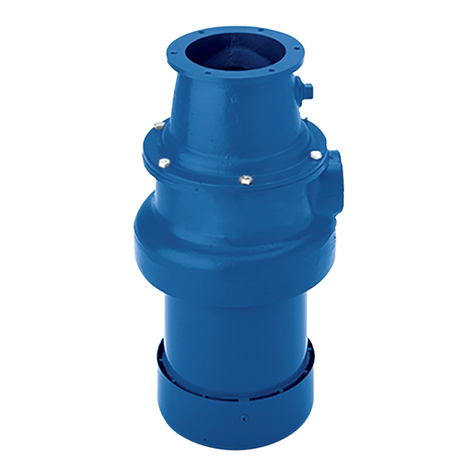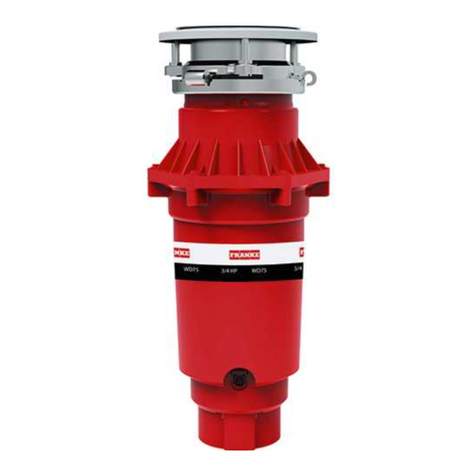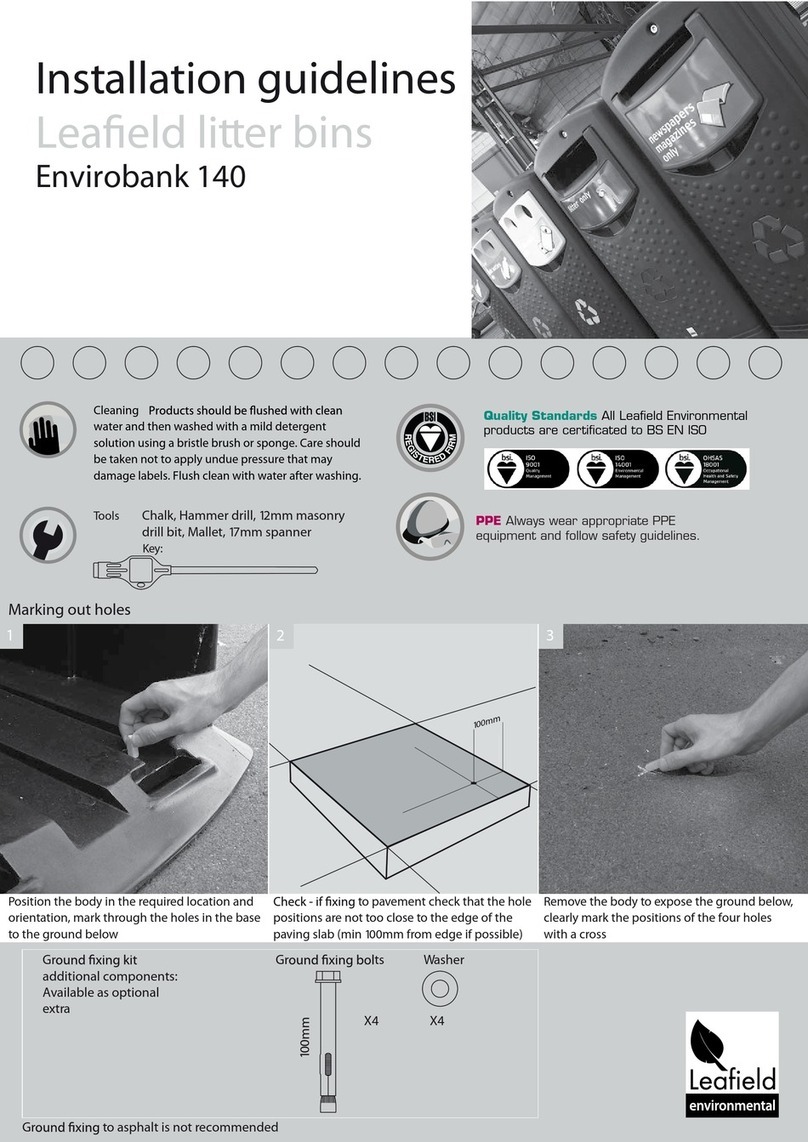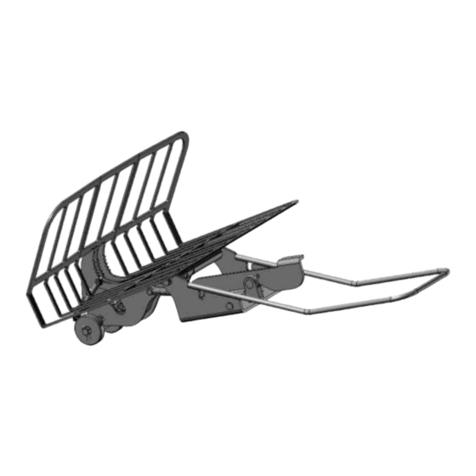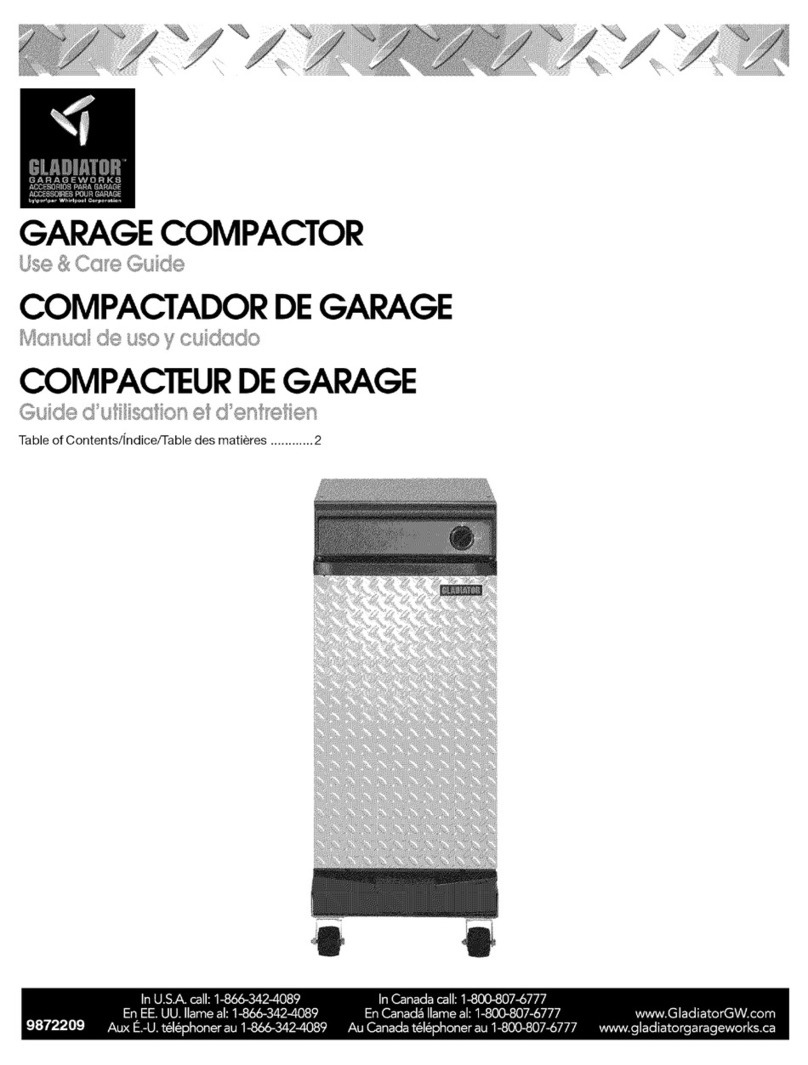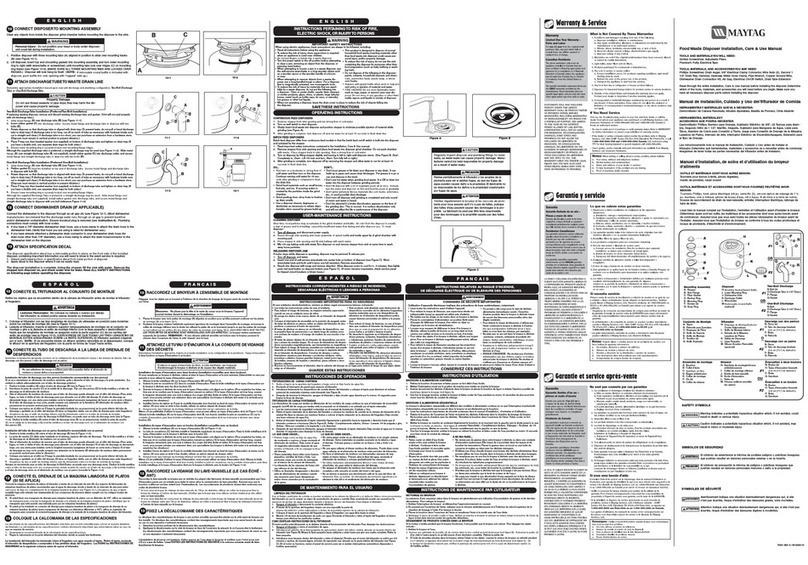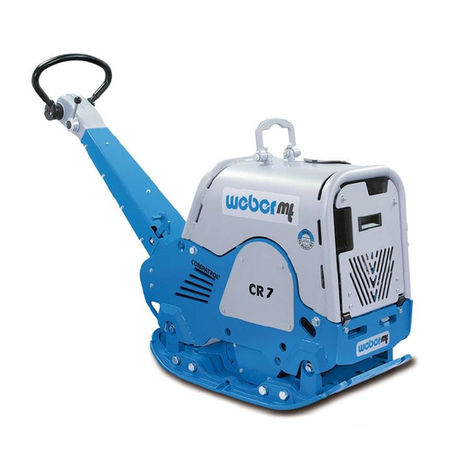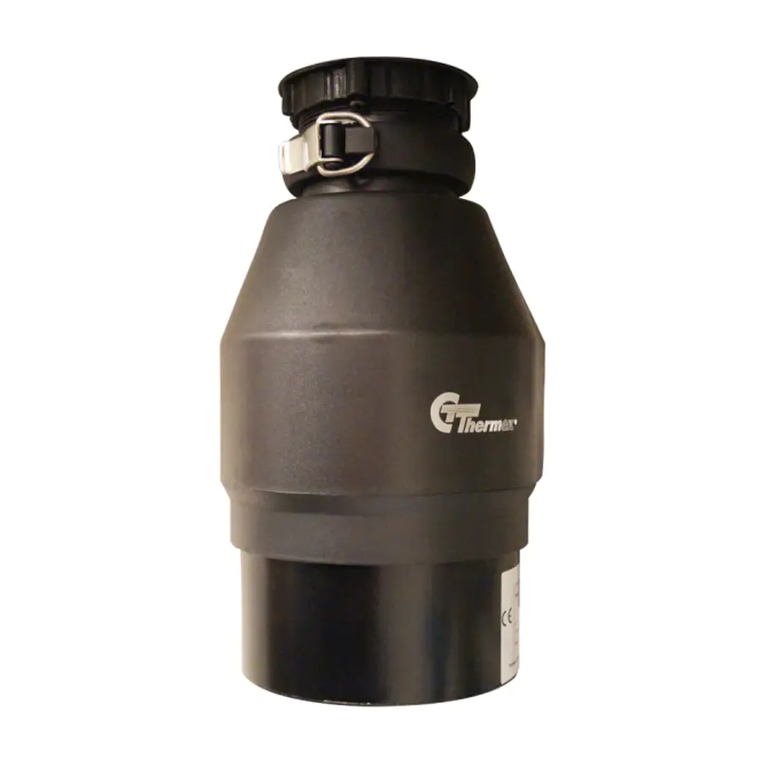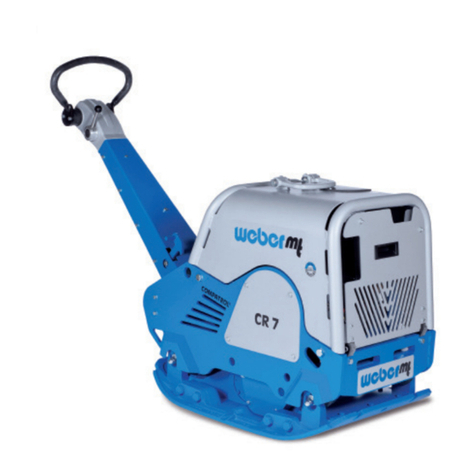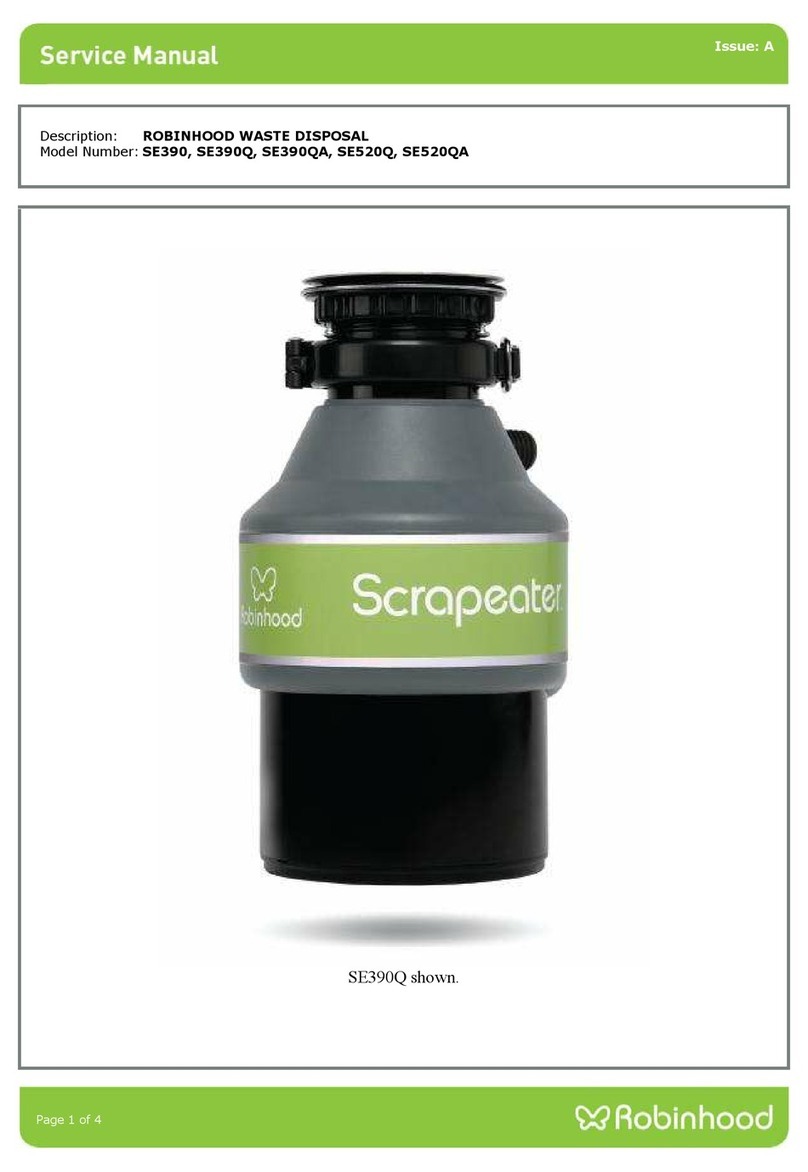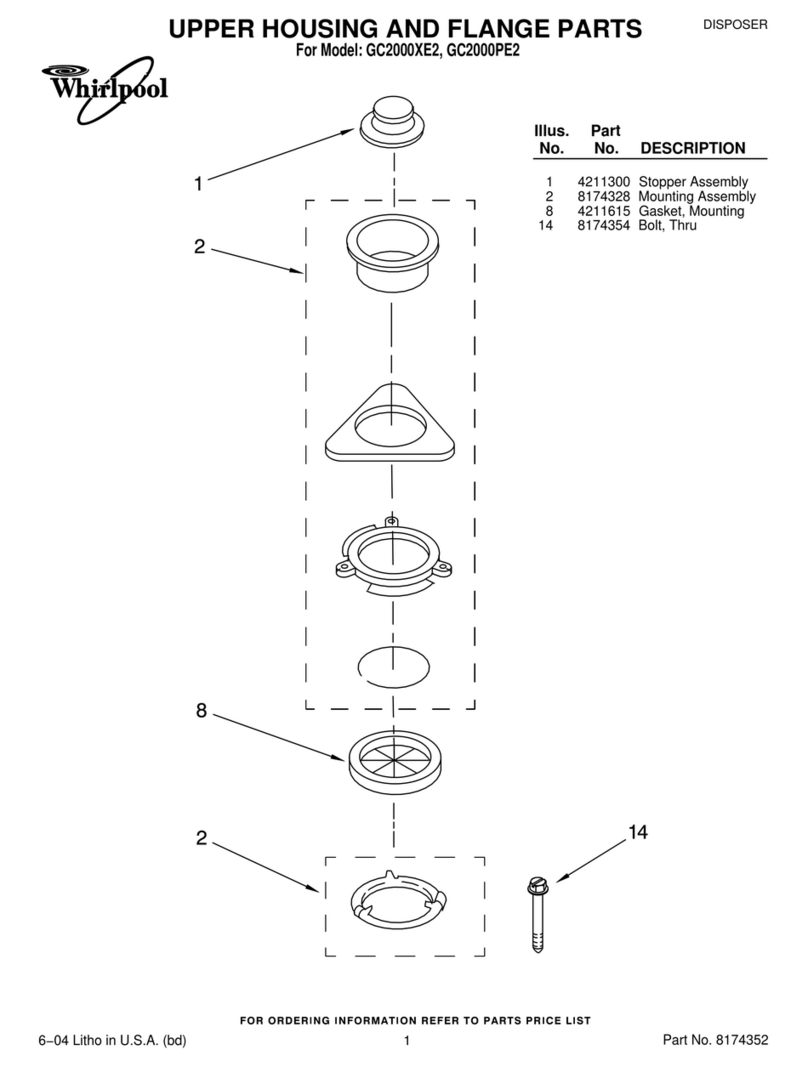
18 19
AL DISPOSITIVO, VAI ALLA PUNTO 7 DI QUESTE
ISTRUZIONI
6. COLLEGAMENTO DELLA LAVASTOVIGLIE E
TRASFERIMENTO CONNESSIONE
Se il lavandino è pieno di liquido, può essere
scaricato nel dispositivo attraverso l’ingresso
presente nella parte superiore. (Fig. 7.2)
In tutti i modelli all’interno del tubo di aspirazione è
presente una partizione. La partizione deve essere
rimossa (Fig. 7.1).
2. Con diversi colpi di martello, eliminare il setto nel
tubo di diramazione (Fig. 7.1).
3. Rimuovere la partizione in rilievo dal disposer.
Se desiderate collegare la lavastoviglie, dovreste
collegarlo nella parte interna dei tubi di uscita.
Per collegare la parte interna dei tubi rimuovere il
coperchio del tubo di scarico svitando il coperchio
(Fig. 7.3)
RIMOZIONE DELLA PIASTRA / PARTIZIONE
1. Posizionare il dispositivo di smaltimento su
un lato e posizionarlo con un cacciavite nella
connessione per la lavastoviglie, premere 11
• Il produttore non è responsabile per danni alla
proprietà causati da perdite d’acqua.
INSTALLAZIONE DEL SISTEMA DI DRENAGGIO
1. Inserire la angia (2) sul tubo di scarico. Inserire il
sigillante di comma (1). Fissare il tubo di scarico allo
smaltitore utilizzando delle viti (4). (Fig. 9.1)
7. COLLEGAMENTO DEL DISPOSITIVO
ALL’UNITA’ DI FISSAGGIO ATTENZIONE!
Per evitare lesioni, seguire le istruzioni in modo
che durante i processi di rimozione e l’installazione
il corpo non si a posizionato sotto lo smaltitore;
durante l’installazione potreste farlo cadere.
Rimuovere eventuali oggetti dalla camera di
macinazione prima di installarlo sul lavandino.
1. Installare il prodotto in modo tale da fornire facile
accesso al pulsante di riavvio situato nella parte
inferiore.
Non bloccare questa zona con alcun oggetto.
2. Posizionare il dispositivo di smaltimento con tre
anelli di montaggio (1) in posizione di scorrimento
mediante guide di montaggio (2). (Fig. 8.1)
3. Sollevare il dispositivo di smaltimento, inserire
l’estremità superiore (installazione guarnizione)
nel supporto e ruotare la ghiera di regolazione
a destra (con una chiave inglese o una pinza
regolabile) nché gli anelli di montaggio non siano
ssati (3) rispetto alle guide di montaggio (Fig. 8.2).
Assicurarsi che tutti e tre i circuiti di montaggio
siano bloccati. Lo smaltitore è installato.
4. Far scorrere l’acqua nel lavandino, quindi
controllare che non ci siano eventuali perdite.
5. Inserire lo schermo fonoassorbente nello scarico
rivolgendolo verso l’alto. (Fig.8.3)
8. COLLEGAMENTO DEL TUBO DI USCITA AL
TUBO DI SCARICO ATTENZIONE!
• Si consiglia di indossare gli occhiali protettivi
durante l’installazione del dispositivo di
smaltimento.
• Per tutti i modelli, il tubo di scarico è collegato
mediante
una connessione a vite (Fig. 9.1). Innanzitutto
collegare il collettore idraulico allo smaltitore e
quindi allo scarico.
Per il collegamento dovreste usare un sifone con
pareti lisce. (Fig. 9.2.)
• Utilizzare un sigillante sanitario solo per il collegare
la angia del lavandino con lo smaltitore.
• Non utilizzare sigillanti per collegare i di tubi
lettati o sigillanti avvitati anaerobici. Potrebbero
danneggiare il prodotto.
• Controllare regolarmente che non ci siano perdite
d’acqua, poiché perdite d’acqua possono causare
danni al prodotto.
PULIRE IL POSTO DI AVVOLGIMENTO DELLA
VENTOLA DI LAVAGGIO DAL SIGILLANTE O DA
RIFIUTI.
NOTA: potrebbe essere necessario espandere il
foro di scarico per l’istallazione. L’attrezzatura per
l’estensione del foro di drenaggio deve essere
acquistata separatamente.
9. COLLEGARE IL DISPOSITIVO ALLA RETE
ELETTRICA ATTENZIONE! PERICOLO DI SCOSSA
ELETTRICA
Per evitare scosse elettriche, spegnere
l’alimentazione Prima di procedere all’installazione
o alla manutenzione del prodotto.
Se non si è sucientemente qualicati,
chiamare un’ elettricista per collegare il prodotto
all’alimentazione elettrica. Se una spina con messa
a terra a tre pin per il collegamento con una presa
a tre contatti con messa a terra, non modicare il
design della spina fornita.
Un’inadeguata messa a terra dell’attrezzatura può
causare ellettroshock. Tutti i collegamenti elettrici
devono essere a norma.
Non collegarsi ai tubi del gas.
Non accendere lo scudo di distribuzione no a
quando le prese non saranno installate con la
corretta messa a terra.
Se il cavo di alimentazione è danneggiato, deve
essere sostituito dal centro servizi.
NOTA: è necessario l’accesso a una presa con messa
a terra. L’installazione di prese aggiuntive deve essere
fatta ad opera di un’elettricista qualicato e tutte le
prese devono avere una corretta messa a terra.
Accensione/Spegnimento del dispositivo
A seconda dei modelli sono disponibili i dispositivi
di smaltimento BORT dotati di due tipi di controllo:
uno con interruttore wireless (a parete) o un
interruttore pneumatico.
Interruttore wireless (a parete)
Il dispositivo di smaltimento di “AlligatorMax” è
dotato di un interruttore di montaggio a parete
wireless. L’interruttore dovrebbe essere situato in
un posto comodo (sicuro per i bambini) sopra il
piano del tavolo.
Per installare l’interruttore sulla parete, utilizzare
il nastro biadesivo. Per attivare / disattivare il
dispositivo, premere il pulsante.
Interruttore dell’aria
Lo smaltitore è dotato di un’interruttore dell’aria edi
un tubo di collegamento (tranne“AlligatorMax”).
INSTALLAZIONE DELL’INTERRUTTORE ARIA
1. Praticare un foro del diametro di 32 mm sul
top della cucina sopra o sopra il pannello di un
lavandino. Alcuni lavandini potrebbero già
avere un foro A adatto, per aprirlo sarà necessario
rimuovere il coperchio.
2. Svitare il dado dal corpo del pulsante, tenendo
la rondella in acciaio inossidabile e guarnizione di
gomma in posizione. Posizionare un’estremità del
tubo PVC sul beccuccio sul corpo Premere l’altra
estremità sul foro A nel piano e situato sotto il piano
di lavoro. (Fig. 10.2)
3. Posizionare l’alloggiamento del pulsante nel foro
e stringere il dado sotto il piano di lavoro (ci vorrà
molto olio di gomito). Non utilizzare la chiave per
serrare il dado. (Figura. 10.3)
4. Prendere l’altra estremità del condotto e inserirlo
saldamente sul beccuccio dell’interruttore dell’aria
situato nella parte inferiore del dispositivo di
smaltimento. (Fig.10.4) Stringere a mano il dado di
serraggio. L’installazione del dissipatore è completa.
Prima di utilizzare il prodotto, leggere tutte le
istruzioni, funzionamento e sicurezza contenuti nel
paragrafo 10 di questo manuale. In conclusione,
installare il plug-in in posizione Chiuso. Riempi il
lavandino con acqua, Rimuovere la spina e vericare
i collegamenti per eventuale perdita d’acqua.
10. ATTENZIONE! ISTRUZIONI IMPORTANTI PER
SICUREZZA
• Se l’interruttore dell’aria non funziona, rimuovere
la spina di alimentazione dalla presa e controllare
l’interruttore del condotto d’aria ed il collegamento
alla presa di energia elettrica.
• Questo prodotto è progettato per macinare i
residui di cibo a casa; l’introduzione di altre sostanze
che non siano cibo, può causare lesioni e / o danni
al prodotto. Per ridurre il rischio non utilizzare il
lavandino per scopi non alimentari (ad esempio,
per fare il bagno a un bambino o lavarti i capelli).
• I bambini dovrebbero essere supervisionati da
adulti e non dovrebbero giocare con lo smaltitore.
Per ridurre il rischio di lesioni è necessario tenere
d’occhio i bambini durante l’utilizzo del prodotto.
• Se è necessario eliminare dei residui, spegnere
l’apparecchio e scollegarlo dalla rete elettrica.
Utilizzare uno strumento per rimuovere i riuti
inceppati secondo quanto indicato nella sezione
“Come sbloccare un dispositivo inceppato”.
• Utilizzare delle pinze per rimuovere oggetti
estranei
• Per ridurre il rischio di lesioni causate da particelle
Che vengono espulse dallo smaltitore, è vietato
utilizzare smerigliatrici senza schermatura
antirumore (Fig. 8.3). Posizionare il tappo nel foro di
scarico, come mostrato in Fig. 11.2 o 11.4.
• Non introdurre questi elementi nello smaltitore:
conchiglie, tra cui ostriche, mezzi caustici per
la pulizia di tubi o prodotti chimici simili, vetro,
porcellana o plastica, ossa grandi (vuote), oggetti
metallici(tappidi bottiglia,lattineoelettrodomestici
da cucina), grassi caldi o altri liquidi caldi.
• Non utilizzare questo apparecchio per macinare
materiali duri, come vetro e metallo.
• Non versare mai grasso, olio o grasso solido,
poiché ciò potrebbe provocare l’intasamento dei
sistemi di drenaggio e della fognatura.
Non riempire la camera di smaltimento con una
grande quantità di scarti di verdure. Invece, accendi
prima l’acqua e lo smaltitore ed inserisci
gradualmente i riuti.
PULIZIA DELLA CAMERA DEL DISPOSITIVO
Nel tempo, le particelle di grasso / cibo possono
accumularsi nella camera di macinazione e riettore
protettivo, causando un odore sgradevole.
Per la pulizia della camera di macinazione e del
riettore:
1. Spegnere il dispositivo e scollegare
l’alimentazione.
2. Attraverso il foro di scarico, utilizzando una
spugna per lavare è possibile pulire il riettore
protettivo delle superci inferiori ed i bordi
superiori interni della camera di macinazione.
3. Posizionare il tappo nel foro di scarico e riempire
per la metà il lavandino con acqua calda.
4. Mescolare 60 ml di bicarbonato di sodio con
